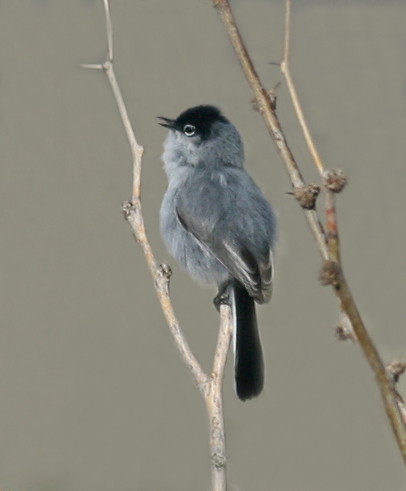
Black-tailed Gnatcatcher,
Indian Ranch (Panamint Valley),
Photo by Tom Heindel
The first record for Inyo County is 8 February 1891 when the A.K. Fisher Expedition found them common at Resting Springs, east of Tecopa, and collected a specimen (Fisher 1893:144). The next reliable record is also from Resting Springs 13 Apr 1978 when J. Evens found them there through the end of his survey 29 June (American Birds 33:93). From 1960 through 1978 there were 11 reports, ten from outside the proven breeding areas and for which there is no evidence. This does not mean that all were incorrectly identified gnatcatchers but some definitely were. Reports from Tollhouse, 1829 m (6000 ft), and Grandview Campground, 2607 m (8550 ft), both in the White Mountains, are significantly higher in elevation than the highest known elevation throughout the Black-tailed Gnatcatcher’s entire range. Another report of 30 birds in Titus Canyon, Grapevine Mountains in Death Valley National Park, is a quantum leap in numbers above surveys in their core breeding area in the Tecopa/Amargosa area. These sightings are obviously suspect.
Grinnell and Miller (1944:370) include southeastern Inyo County (Resting Springs and Mesquite Spring) and the eastern two–thirds of San Bernardino County as the northern range of Black-tailed Gnatcatcher based on four literature references and two specimens along the stateline near Needles. This is an immense area based on so few data and may have helped contribute to the idea that if you are in the eastern desert, you will be seeing Black-tailed Gnatcatchers. The report from Mesquite Springs was cited “Willet fide Michener MS [manuscript]” indicating that this was not a specimen; Garrett and Dunn (1981:291) published the report and stated that it was probably a Blue-gray Gnatcatcher, a common breeder there. During the 1980s, eight records came from the core proven breeding area while 19 others were scattered all over the county including Schulman Grove, 10,000ft, in the White Mountains and 30 more birds found at Salt Creek, Death Valley National Park. Then a turn-around occurred 1990-2010 when 42 reliable records were received and only six raised questions. Inyo County has 87 reports with 52 considered reliable records and 35 red-lined. There is no doubt that some of the red-lined reports are correctly identified but lacking evidence they cannot be distinguished from those reports that are beyond the known data for the species. Some of the red-lined reports are from some of the best birders in the state, which means that this species may exist in areas previously unproven or that even the best of birders may be too casual when seeing gnatcatchers in the desert!
Black-tailed Gnatcatchers are declining throughout the Southwest based on Breeding Bird Surveys (Sauer et al. 2005). Since this gnatcatcher does not tolerate man well and avoids roads and developed areas, the incursion of man into its habitat does not bode well for the species. Partners in Flight have recognized the problem and have included the Black-tailed Gnatcatcher as a Stewardship species for the Southwest (Rich et al. 2004). The preferred avoidance of mankind’s accoutrements makes surveying for this species far more difficult than a Breeding Bird Survey, which counts species found near roads. That said, many records are along seldom used dirt roads in southeast Inyo County.
The known breeding areas are China Ranch and nearby Western Talc Road, Tecopa area, Resting Springs, Shoshone, Amargosa drainage, and Indian Ranch in the Panamint Valley. Black-tailed Gnatcatchers found away from these locations must be treated like casual vagrants! Document, document, document, and photographs preferred. Locations where they have been reported, without any evidence, are from Death Valley National Park: Furnace Creek Ranch, Mesquite Springs, Scotty’s Castle, Stovepipe Wells, Westside Road, Anvil Spring, Greenwater Valley, Hanaupah and Johnson Canyons in the Panamint Mountains, Tin Mountain Wash, Travertine Spring, Upper Cottonwood Canyon in the Cottonwood Mountains, Wildrose Canyon, Saline Valley, and Willow Springs in Butte Valley.

Black-tailed Gnatcatcher,
March 30, 2011, Indian Ranch (Panamint Valley)
Photo by Tom Heindel
Remember, if you are within the known breeding area, the southeastern tip of Inyo County, and you think you are looking at a Black-tailed Gnatcatcher, you probably are and documentation is not necessary. If you are outside the known breeding area and you think you are looking at a Black-tailed Gnatcatcher, prove it! Other researchers are also trying to clarify the range of Black-tailed Gnatcatcher farther south in the Mojave Desert where the overall problems are similar to those in Inyo County. Where are they, and where aren’t they, and exactly what are their habitat needs. We encourage adventurous spirits to take one of the sites outside the known breeding areas and prove, to a scientific certainty, that the range of the breeding population of Black-tailed Gnatcatcher is more extensive in Inyo County than is presently proven! This is an area where birders can make significant contributions to the science of ornithology!
Comments and perspectives, offered by Jon Dunn, Matt Heindel, and Kelli Levinson, were greatly appreciated and added significantly to this article.
Bibliography
- Fisher, A.K. “Report on the ornithology of the Death Valley expedition of 1891, comprising notes on the birds observed in southern California, southern Nevada, and parts of Arizona and Utah.” North American Fauna No. 7:144 (1893).
- Floyd, T, Elphick, C.S., Chisholm, G., Mack, K., Elston, R. G., Ammon, E. M., and Boone, J. D. Atlas of the Breeding Birds of Nevada. University of Nevada Press, 2007.
- Grinnell, J., and Miller, A. H. “The Distribution of the Birds of California.” Pacific Coast Avifauna Number 27 (1944).
- Miller, A. H., and Stebbins, R. C. The Lives of Desert Animals in Joshua Tree National Monument [Park]. University of California Press, 1964.
- Patten, Michael A., Guy McCaskie, and Philip Unitt. Birds of the Salton Sea: Status, Biogeography, and Ecology. Berkeley: University of California, 2003.
- Rich, T..D., et al. Partners in Flight: North American Landbird Conservation Plan. Ithaca: Cornell Laboratory of Ornithology, 2004.
- Sauer, J. R., Hines, J. E., and Fallon, J. “The North American Breeding Bird Survey, Results and Analysis 1966 – 2005. Version 6.2.2006.” USGS Patuxent Wildlife Research Center, Laurel, MD, 2005.
- Unitt, P. San Diego County Bird Atlas, San Diego Natural History Museum, 2004.

